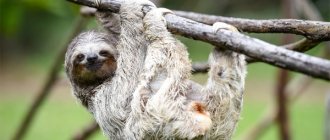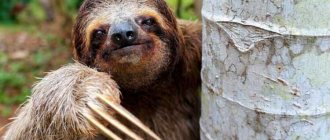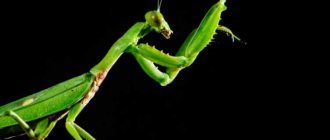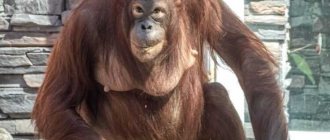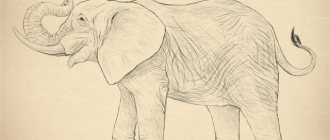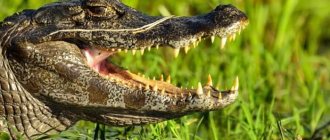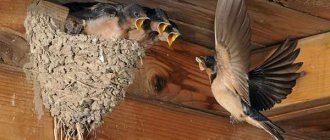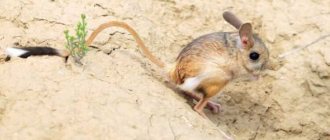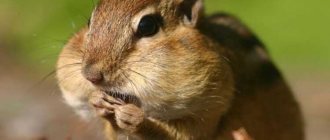Review author: “ZooVita”
Any caterpillar is a butterfly larva. In its original form, the caterpillar exists for up to 3 weeks, after which it wraps itself in a cocoon and transforms into one of the many species of butterflies.
Interestingly, most butterflies are pests, but their “children” cause the greatest damage to agricultural crops.
Where do caterpillars live?
Habitat for caterpillars
Most caterpillars live in the ground. Some of these insects live in bodies of water, while others live both on soil and in water, adapting to existence everywhere. There are two categories of larvae depending on their living conditions: secretive and free-living. The following types of larvae are classified as secretive:
Caterpillar habitat
The second variety is caterpillars that live on leaves, which they themselves eat. These are most species of larvae of the largest butterflies.
Spicebush Swallowtail
At first glance, this creature looks more like a fish or lizard than a caterpillar. Huge false eyes scare away predators. In addition, during its life of a couple of months, the larva changes color - the egg hatches chocolate brown with large white spots, then becomes bright emerald, and before pupation - orange with a red belly.
The black-blue velvet butterfly is common in North America; in some places it gathers in colonies of hundreds of thousands of specimens.
What do caterpillars eat?
Eating caterpillars
An insect that has just been born eats the top layer of the egg in which it grew. After this, the “worm” proceeds to its main meal. Each type of larvae has its own diet. Most caterpillars eat vegetation: fruits and various green masses. Larvae can be divided into 4 categories depending on their food supply:
- Polyphages - consume all plants without exception. This species includes, for example, the caterpillars of moths.
- Oligophages - prefer to consume specific plants. For example, umbrella bushes.
- Monophagous - they eat only one type of plant. For example, silkworm larvae consume only mulberry leaves.
- Xylophages - the food base of this species is wood.
Food of caterpillars
It is worth noting certain types of caterpillars, which cannot be combined into any category, since there are few of them, but they exist:
- Caterpillars of gray or black granary moths eat only fungi of the tinder type or lichens. Poisonous spores are the main type of food for such larvae.
- There are representatives of larvae in the world that eat the outer covering of animals : particles of horns, wool, skin, hair.
- Some types of caterpillars consume wax and even honey.
- Predatory insects - there are few representatives of this species. Cases of predation occur if the population increases greatly and there is a shortage of regular food. For example, bollworm larvae attack caterpillars of their own species that are weakened or sick. Some species eat aphids, small insects and scale insects. To do this, they have special hunting devices in the form of a large mouth, sticky legs, and so on.
- Parasitic larvae settle on representatives of specific insects . Some types of larvae settle on the hairs of caterpillars. Because of this, the host insect dies.
- Certain species of caterpillars live in ant heaps . In this case, their main food is small insects. Attracting the victim occurs with the help of special sounds that the larva makes or a special sweet liquid that is secreted by its secretory functions.
Each type of caterpillar has its own diet, and it depends on the category of these larvae, their mode of existence and habitat.
Malinnitsa is a modest record holder
commons.wikimedia.org by Charles J Sharp. Callophrys rubi, wingspan 26-28 mm
The raspberry and the raspberry blueberry are the same butterfly from the genus Greenfinch. It is not easy to notice it, because... the outside of the insect is brown and the inside is green. In addition, the butterfly is small and almost always keeps its wings folded for camouflage. You can meet her not only at the dacha, where she flies for flower nectar, but also in swamps and meadows. Raspberries are common in the temperate zone of Eurasia. The butterfly's habitat reaches the Polar Urals, and in the Alps it sometimes rises to a height of up to 1800 m!
insectamo.ru, author: Ponomarev A. G.
Raspberry caterpillars have a fairly rich “menu”, which includes leaves of blueberry, heather, birch, gorse, buckthorn and other plants. What about raspberries, you ask? Alas, raspberry caterpillars really will not refuse raspberry and currant leaves. But despite their food preferences, they are rare on these plants. Insects are sensitive to chemicals, so they prefer to stay away from summer cottages. In addition, this species is quite rare in nature.
Some blueberry caterpillars are able to pass themselves off as ant larvae. As a result, the ants feed the caterpillars, and the latter, without hesitation, also eat the eggs and larvae of their benefactors.
How to attract raspberries. The raspberry tree is not one of those butterflies that will circle brightly over a flower bed. But if you have clover, sweet peas or vetch, she may come briefly to collect sweet nectar.
Body structure of a caterpillar: description, photo
Body structure of a caterpillar
Any caterpillar consists of the following body parts:
- Torso
- Head
- Breast
- Abdomen
- Pairs of legs
- Spiracle
- Mouthparts
- Eyes
The body of such an insect consists of a head, abdomen, chest and several pairs of legs.
Hawkmoth
The structure of the head of different types of insects can be different - from the most unusual with “horns” to a real imitation of other inhabitants of the Earth, for example, snakes and even fairy dragons.
Dragon caterpillar Snake-like caterpillar (lat. Hemeroplanes triptolemus)
Swallowtail caterpillar that looks like a snake
Pink caterpillar citheronia royal, similar to a dragon (lat. Citheronia regalis)
The head of the larvae consists of six fused segments that form a hard capsule. In the area between the forehead and eyes, the cheek area is highlighted. At the bottom of the head there is a heart-shaped occipital foramen.
Caterpillar
The head of most caterpillars is round, although it can be triangular or rectangular. The parietal part usually protrudes, forming a "horn". Antennae grow on the sides of the head.
Saturnia butterfly caterpillar
The oral apparatus of such insects has well-formed gnawing upper jaws with teeth, thanks to which the “worm” gnaws or tears food tissue. There are tubercles on the inside that help chew food. Saliva is converted into a special spinning secretion.
Caterpillar mouth
The eyes of larvae are the simplest visual system. The eye of this insect consists of one lens. The eyes are on the head and are located one after another along an arched line. Some insects may have one eye, but it has a complex structure and is fused together from five simple lenses. There may also be another eye located on the inside of the arch. It turns out that almost every caterpillar has 5-6 pairs of eyes.
Caterpillar eyes
The body of this insect is well mobile due to the soft tissues of the shell. Consists of separate departments. The anus is closed by lobes with varying degrees of development.
Torso
spiracle is a stigma that is located on the chest. In larvae living in water, the respiratory organs are tracheal gills.
Harpy
Each caterpillar has several pairs of legs, some of them ending in specific hooks. The legs, which are located on the chest, have a sole with a claw. With its help, the insect moves by protruding or retracting its abdomen.
Caterpillar legs
The body of an insect is necessarily covered with hairs, outgrowths or cuticles of various shapes: stars, needles, cones or bristles. Shaggy villi can be located either in the form of individual threads or in the form of tufted clumps on the back or tail. Almost all the fluffy caterpillars are very beautiful and then transform into the most attractive butterflies.
Yellow hairy caterpillar
Social structure and reproduction
Photo: Pair of caterpillars
Caterpillars are ready to become butterflies from birth. Even in the smallest caterpillar, freshly hatched from a tiny egg, bundles of cells for organs such as antennae, wings, legs and genitals are already primed and destined to become adults. Called imaginal discs (being flat and round), they are unable to grow and develop due to the constant leaching of juvenile hormone.
As the larva feeds, its intestine, muscles and some other internal organs grow and develop, but the imaginal discs are temporarily suppressed and remain dormant. The caterpillar behaves like a free-living, feeding, growing, but developmentally suppressed embryo.
When it reaches a critical size, the molting hormone, ecdysone, is released. It sheds its skin several times in response to ecdysone, each time forming a new instar (stage), but the juvenile hormone keeps it in the caterpillar, preventing further development until its concentration approaches full size and the concentration of the latter decreases.
In the fifth and final instar of the caterpillar, the imaginal discs are already beginning to emerge from forced dormancy and grow. Juvenile hormone now falls below threshold and the next surge of ecdysone stimulates transformation into pupa. The flattened imaginal discs begin to develop unhindered. Each folds into a concave dome, then takes the shape of a sock. The center of each disc is designed to become a limb—the tip of a paw or the tip of a wing.
Much of the caterpillar's plump mass is processed into adult features, which merge into the inner shell of the pupa. At this stage, the interior consists mainly of a nutrient soup that nourishes the embryonic imaginal discs as they complete their delayed development. The final surge of ecdysone occurs amid nearly zero juvenile hormone—and stimulates the emergence of the adult butterfly to mate, disperse, and lay eggs.
Caterpillar development: description, photo
Development of a caterpillar
Depending on the species, a butterfly larva can transform into a flying beauty from several weeks to several years. In the northern regions, the warm season does not last long, so the life cycle of the caterpillars can last two years. Some types of larvae live in the caterpillar stage for up to 12-14 years.
During its development, the larva changes in size and appearance. For example, from an ugly and naked larva it turns into a fluffy caterpillar. The caterpillar then turns into a chrysalis, from which a beautiful butterfly then emerges.
Meadow pestle is a poisonous insect
Zygaenidae, wingspan 16-38 mm
Groups of pests often flutter over flower beds in sunny weather. Insects are easy to recognize: they have rounded red spots on their dark blue or green wings. In addition, unlike other butterflies, the wings of the meadow moth are folded like a roof, like those of moths. If a butterfly is caught, it will begin to secrete repellent foam. In nature, no one hunts a butterfly. It is poisonous and itself very resistant to poisons.
Caterpillars of moths are densely covered with warts, from which small bristles protrude. Body color: yellow-green with a scattering of black spots. Caterpillars can also secrete protective substances, so it is better not to handle insects with your bare hands. They feed mainly on clover and grasshoppers.
How to attract meadow moth. Plant clover, plantain, alfalfa or thyme in the area. The butterfly will also be happy with the dandelion, but usually, on the contrary, they try to remove it from the site.
- How to get rid of dandelions on your property - useful tips for summer residents
Dandelions feel great in your area and threaten to “take over” it completely? Fight the weeds!
Transformation of a caterpillar into a butterfly: description, photo
The pupa is usually cylindrical or round in shape. The color of the cylinder is monochromatic - green or light green. It may have a pattern on the surface in the form of stripes, dots or spots. When a butterfly is in the pupa stage, it already has wings, legs and a proboscis.
Caterpillar pupa turns into a butterfly
Peacock eye cecropia (Hyalophora cecropia)
The caterpillar is very poisonous, so with all its bright color it shows that it is better not to touch it. The tubercles have a rich color and additionally have dots, like those of poisonous ladybugs.
The peacock eye is the largest moth in America - larger than the palm of your hand.
Beautiful caterpillars: name, characteristics, what it looks like, what kind of butterfly it turns out, description, photo
Nature has made even certain types of caterpillars beautiful so that we can admire their uniqueness. Their luxurious hairs and interesting colors delight you and you want to look at such a natural phenomenon without taking your eyes off.
Beautiful caterpillars
Saturnia Io
Saturnia Io (Automeris io) is a beautiful caterpillar with green hairs in the form of pompoms. It is impossible to even imagine that a larva with such a color turns into a red butterfly. She seems to look with her black eyes located on her pink-yellow lower wings.
Blue Morpho Blue Morpho
Blue Morpho - it is impossible to pass by at the sight of such a caterpillar. I want to look at every color stroke on the surface of her body. She is a dream for any artist. Transforms into a small blue butterfly.
Slug
Slug butterfly
Slug worm (Isochaetes beutenmuelleri) - looks like an ornament that is made of blue glass covered in fake snow. The fabulousness of this caterpillar is given by the fibers in the form of needles. They seem to be covered with real frost. The butterfly is a regular brown moth.
Peacock's eye - the most picturesque butterfly of the middle zone
Aglais io, wingspan up to 62 mm
This butterfly will not leave any summer resident indifferent! The insect will decorate any flower garden and its offspring will not cause any harm to the garden. The round spots on the front and hind wings of the butterfly are very reminiscent of the spots on the tail of a peacock. With the help of such a cunning device, the peacock's eye often confuses birds that would like to feast on the butterfly.
dic.academic.ru
The peacock eye caterpillar is not so noticeable, although its black spines can also scare off enemies. Black caterpillars live in large colonies of up to several dozen individuals. They mainly prefer to eat nettles, thistles or hops, and less often – willow and raspberries.
How to attract a peacock eye. These butterflies are excellent pollinators. To attract them to the garden, plant flowers in shades of red, pink, orange or yellow in your flower bed. And also plant some nettles in the area.
How to control peacock eye caterpillars. An invasion of caterpillars can damage the raspberry tree, but if in the spring you treated the plantings with insecticides as standard, do not worry about the safety of the crop. It is easier to remove pest colonies manually.
Caterpillars with spikes: name, characteristics, what it looks like, what kind of butterfly it turns out, description, photo
Caterpillars with spikes do not look intimidating. They are beautiful, bright and interesting, you can look at them for hours. But it is better not to touch such caterpillars with your hands, since many species can be poisonous, and the spines are their weapon for protection from the enemy, through which they release poison.
Tracks with spikes
Butterfly caterpillar with spines
Caterpillar "Burning Rose" - its spines are located on the cuticles of the body. As it develops, it turns into a delicate moth with iridescent beige and greenish wings.
Aglais urticae
Butterfly Aglais urticae
The spiny Aglais urticae - a caterpillar that looks like a piece of black coal turns into a beautiful Peacock butterfly - bright and with an interesting color. Lives in America and mountainous forests of Asia.
Dryas Julia
Dryas Julia - Attacus atlas caterpillar is a brown and white caterpillar with black spines. Lives in Thailand and the island of Java. It turns into one of the largest butterflies in the world, with a wingspan of up to 25 centimeters.
Appearance and features
Photo: What a caterpillar looks like
The most common caterpillars are:
- large white caterpillar (Pieris brassicae), the adults of which are called cabbage white butterflies. The caterpillars accumulate high concentrations of mustard oil in their diet, and their bright, spotted bodies alert potential predators to their unpleasant taste;
- small turtle caterpillar (Aglais urticae). Living together benefits caterpillars because they can combine their bodies in unison, acting as one large organism in an attempt to ward off predators. Eventually, individual caterpillars crawl away separately to pupate. Tortoiseshell caterpillars can be seen from May to June, with adults potentially active throughout the year;
- comma caterpillar (Polygonia c-album). The caterpillars change color quite a bit throughout their larval stage, but the older caterpillars are the most distinctive. Scorched orange and black hatchlings develop a white "saddle" mark, reminiscent of a bird's shedding, which deters predators;
- bloody bear caterpillar (Tyria jacobaeae). Growing up to 28mm, these black and yellow caterpillars are very distinctive and easy to identify as they look like they are wearing a rugby shirt;
- silver hole caterpillar (Phalera bucephala). This black and yellow caterpillar reaches 70 mm in length and has hairs that are irritating to humans and good at protecting themselves from predators;
- caterpillar of the pale tuberculate moth (Calliteara pudibunda). The caterpillars can grow up to 45mm and reach full size in about two months. The stubble on the caterpillar's body is known to cause skin irritation in humans. The adults are a beautiful gray moth with comb-like antennae;
- caterpillar of the maple moth (Acronicta aceris). It is an urban species, distinguished by bright orange hair and black and white diamond patterns along the back;
- caterpillar of the Acronicta psi. After hatching from the eggs, which only take a week to hatch, the caterpillars grow to 40mm within about thirty days. Gray caterpillars can be found from July to early October. The whitish adults are active from mid-May to August. Their yellow stripe serves as camouflage on plant stems.
Now you know what a caterpillar looks like. Let's find out where this insect is found.
Poisonous caterpillars: name, characteristics, what it looks like, what kind of butterfly it turns out, description, photo
A person should be wary of poisonous caterpillars. You cannot pick them up or even come close. Many species cause a burning sensation on the skin upon contact with the insect’s body, while others can even be life-threatening: breathing rhythm is disrupted, heart palpitations, headaches, and so on occur.
Poisonous caterpillars
Poison caterpillar butterfly
Flannel Moth - This poisonous caterpillar looks like a small hamster. Her butterfly is no less beautiful. But it is strictly forbidden to touch it with your hands, as it causes an allergic reaction and even a feeling of suffocation.
Lazy clown caterpillar
Lazy clown caterpillar butterfly
The “lazy clown” caterpillar (lat. Lonomia obliqua) lives in Uruguay. A highly poisonous insect that secretes a special natural toxin. The venom of this caterpillar causes skin burns. In addition, the toxin can penetrate through the skin to internal organs and cause hemorrhage, for example, in the gastrointestinal tract, kidneys, and also causes pulmonary edema and disruption of the central nervous system.
Saturnia Mayan caterpillar
Saturnia Maya caterpillar butterfly
Saturnia Maya caterpillar (Hemileuca maia) -
covered with hollow spines, upon contact with which, a burning sensation on the skin, rash and nausea appears.
The appearance of this caterpillar should be frightening, because a crawling, hairy insect with black spines will disgust any person. This caterpillar lives in our latitudes on oaks and willows. The butterfly from this caterpillar is also black in color with a hairy body, but it is not poisonous. Volyanka caterpillar
Orgyia leucostigma
caterpillar butterfly
— you won’t be able to pass by such a caterpillar, since it is noticeable thanks to its red head and white body.
Eats everything green and woody in its path. If you touch the hairs of this insect, burns and irritation immediately occur. The rash may not go away for several weeks. White cedar moth caterpillar
White cedar moth caterpillar butterfly
White cedar moth caterpillar (leptocneria reducta)
- lives on a cedar tree in several groups at the same time, eating every single leaf. Contact with the hairs of this caterpillar causes irritation, but not for all people. If a person has sensitive skin, they will most likely feel a burn and develop a rash.
Remember: Beautiful caterpillars are almost always poisonous. Their bright colors are designed to scare away predators. Therefore, if you see, for example, a blue caterpillar with an orange head or a green caterpillar with bright red, blue or black spots, try not to touch such insects with your hands and move away from them.
Willow ribbonwort - twilight guest
freenatureimages.eu. Catocala electa, wingspan – 65-88 mm
The second name of this butterfly is willow ribbon. The insect leads a crepuscular lifestyle, so you are unlikely to see it during the day. The butterfly's front wings are gray and inconspicuous, but the lower wings are bright red with black edging and spots in the middle. Moreover, in males the raspberry shade predominates, and in females it is red. The Ribbonwort can also be seen in the fall. It is most often found near bodies of water, in meadows and wetlands. It feeds on tree sap.
pyrgus.de
Caterpillars of the willow tapeworm are perfectly camouflaged. The yellow-gray body is covered with small black dots, the head is brown. The insect feeds on willow and poplar leaves, so it does not harm garden crops. But if you have a willow growing on your site, be vigilant.
How to attract a ribbon girl. It would seem that the insect is nocturnal - why attract it? You can do this at least just to see this amazing butterfly. In the evening, turn on a flashlight or other artificial light source - and the ribbon fly will come to visit you.
Interesting facts about caterpillars
Caterpillars are amazing insects. Ordinary people don’t know much about them and think that they are ordinary worms that crawl through trees. Only entomological specialists know everything about caterpillars. Here are interesting facts about these insects:
- Entomophagy, or the eating of insects, has flourished on Earth since ancient times. Caterpillars occupy a place of honor among gourmets. They are eaten raw, dried, fried, with sauces, and omelettes.
- The silkworm caterpillar is specially bred in many countries. From 100 kg of cocoons, 9 kilograms of silk thread are obtained.
- The color of any caterpillar imitates the living conditions of this insect. This is an excellent means of camouflage and protection.
- The caterpillar's body contains 4,000 muscles. For comparison, a person has only 629 of them.
- During the first two months of life, the caterpillar eats a lot of plant food, which helps it increase in size up to 20,000 times its original weight.
- Caterpillars that live in northern latitudes do not have time to complete the entire development cycle in one season, and therefore they remain overwintering in cocoons. It is worth noting that in this state the caterpillar can withstand frost temperatures down to -70 degrees.
- Some types of caterpillars live in anthills, making special sounds and secreting enzymes. The ants think that the caterpillar is their queen, so they feed it and take care of it.
- Certain species of caterpillars become poisonous due to the food they eat. For example, the caterpillars of the moss bear feed on poisonous ragwort. Their body begins to release toxins, making these insects a threat to animals and people.
Caterpillars are amazing creatures of nature. There are many different species, and almost all of them turn into beautiful and graceful butterflies that adorn our lives.
Black Swallowtail
The caterpillar of the black swallowtail is very bright and noticeable - so that predators do not covet it. Although in fact it is quite edible.
This is undoubtedly one of the most beautiful European butterflies. During the flight, you can see how the color of the wings of the black swallowtail shimmers.
Moth (Acharia Stimulea)
This strange creature of incomprehensible color, with a bright green blanket, is a very dangerous creature. Each shoot secretes poison, and even one touch to the caterpillar can put an adult in the hospital.
And the butterfly is an ordinary night moth, almost invisible.
Dalcerida (Acraga coa)
The Dalcerida caterpillar appears glassy and transparent.
At the same time, the butterfly itself is very shaggy, brick-colored. Refers to moths. Lives in the tropical forests of Mexico.
Flannel Moth
This is not a tuft of fur on a bush, but the larva of a flannel moth. Very poisonous creature!!! Under no circumstances should you touch it!
Adult flannel moths appear soft and cuddly, but they are also poisonous. Found in the USA and Mexico.
Greta Oto, or Glass Winged Butterfly
The caterpillar of the incredible Greta butterfly looks ordinary and does not attract attention.
But the glass butterfly with transparent wings looks simply amazing. This species lives in Mexico and throughout South America.
Tailed Emperor Butterfly (Polyura Sempronius)
This is not a dinosaur, but a soft imperial caterpillar. Its size is up to 2 cm, and the shell visually enlarges the baby and scares the birds.
The “tailed emperor” is found only in Australia and feeds on nectar from only one plant.
Silkmoth (Hubbard's Small Silkmoth)
This is exactly the famous caterpillar that makes silk thread, and people make wonderful fabric from it. These larvae eat only mulberry or mulberry leaves.
The silkworm butterfly is nocturnal.
